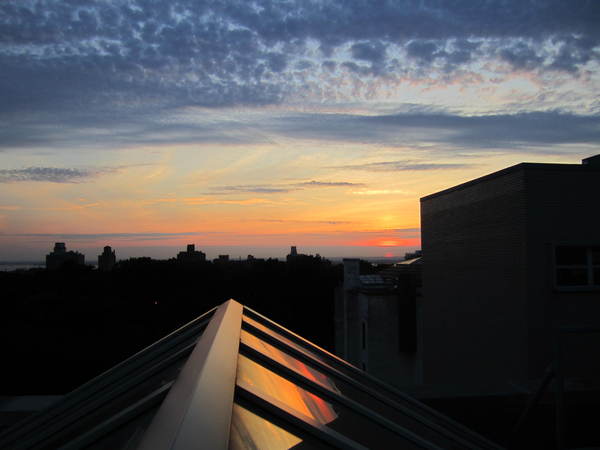A Sunset for 1stfans
It’s been roughly three and half years since Will Cary and I started the 1stfans Membership program at the Museum; come July, the program will come to a close with a sunset—quite literally.

How do you end a program with personal ties? You throw a party and, in the case of 1stfans, that will be our annual rooftop ice cream social where we watch the sun go down; this was the scene at last year's event.
The program was announced in December of 2008 and was created for the Brooklyn Museum visitor who wanted something a little different than the traditional Membership structure. That very idea was the program’s greatest strength, but also its biggest weakness.
1stfans allowed us to see that most individuals looking to truly support us are interested in a deeper and more personal connection with the Museum and, often, people are looking for a more social experience within the structure of events and their relationship with the institution. It was the deep engagement of the program that was incredibly successful, but 1stfans was its own entity that was never fully integrated into the Membership structure. This separation made it difficult to gain awareness for the program and, as such, the growth rate stalled. Most importantly, this separation made it difficult to move 1stfans up the membership ladder—something that’s incredibly important in development and the lifecycle of membership growth. Simply put the program was too separate for its own good; keeping the program in a silo was the primary reason the program couldn’t succeed. The challenge for us moving forward will be to take what we learned about deep engagement and create new programs that both scale well and will be more a part of the institution as a whole—we’ve got some news on that coming next week.
I’ve already written a lot about our use of various social platforms to run 1stfans. If you remember, we found utilizing Facebook and Twitter to be overwhelmingly time consuming and shifted to Meetup.com in late 2010. The shift to Meetup made the administration of the program much easier for us and solved many issues, but in the end the choice of platform didn’t matter much outside of the administration of it. The growth rate was pretty much consistent from one platform to the other and the personal nature of the program remained as successful no matter which site we used. The age old finding that different people are on different platforms rang true—as we moved from one setup to the other, we saw a lot of new faces while many from the original disappeared. Moving platforms did shift the membership base, but the personal nature remained the same and the growth rate almost parallel.
At conferences, people always ask me how do you end something like this when you’ve got all these personal relationships and strong ties. My response has always been, “with transparency…and then you throw a heck of a party.” As 1stfans comes to a close, we’ve written each Member personally and our final event will be the ice cream social on the roof where we gather to watch the sunset from one of the best views in the borough. This event is the party that 1stfans look forward to all year and we’ll be sunsetting the program with a literal sunset.
For those of you who have supported the Museum by becoming 1stfans at one point in our program’s history, we can’t thank you enough; your support over the years humbles me personally. So many of you have become friends and are faces that I’ve come to look forward to seeing at our monthly meetups. I’m looking forward to sharing the roof with you one last time.

Shelley Bernstein is the former Vice Director of Digital Engagement & Technology at the Brooklyn Museum where she spearheaded digital projects with public participation at their center. In the most recent example—ASK Brooklyn Museum—visitors ask questions using their mobile devices and experts answer in real time. She organized three award-winning projects—Click! A Crowd-Curated Exhibition, Split Second: Indian Paintings, GO: a community-curated open studio project—which enabled the public to participate in the exhibition process.
Shelley was named one of the 40 Under 40 in Crain's New York Business and her work on the Museum's digital strategy has been featured in the New York Times.
In 2016, Shelley joined the staff at the Barnes Foundation as the Deputy Director of Digital Initiatives and Chief Experience Officer.
